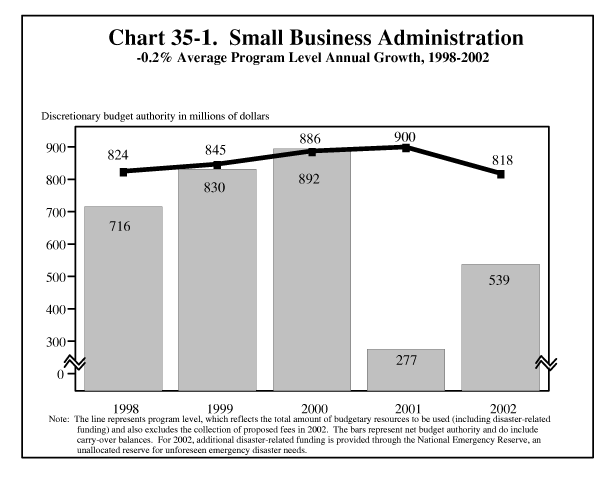
- Afghanistan
- Africa
- Budget Management
- Defense
- Economy
- Education
- Energy
- Environment
- Global Diplomacy
- Health Care
- Homeland Security
- Immigration
- International Trade
- Iraq
- Judicial Nominations
- Middle East
- National Security
- Veterans
|
Home >
News & Policies
|
35. Small Business Administration
|
Initiatives
Drug Free Workplace Program: The 2002 Budget supports grants to organizations that help small businesses develop employee education programs and company drug policies. To date, the Small Business Administration (SBA) has not been able to meet the demand for assistance from intermediary partners; in 1999 SBA received 160 grant applications from intermediaries, but issued only 16 grants. To help meet this need, the President's Budget includes $5 million and proposes to spend $25 million over the next five years.
The New Freedom Initiative: The budget includes $5 million for technical assistance to help small businesses comply with the Americans with Disabilities Act, serve customers, and hire more people with disabilities.

Redirected Resources
7(a) General Business Loan and Small Business Investment Company Securities programs: These programs will become self-financing by increasing fees. The budget acknowledges that some small businesses may have trouble accessing private capital in the absence of a Government guarantee, but does not require the Government to subsidize their cost of borrowing. The budget increases fees sufficiently to make these programs self-financing and would save $141 million.
Small Business Development Centers (SBDCs): The SBDCs program will impose nominal fees for its services, thereby recognizing that these services have value while decreasing the SBDCs' reliance on Federal assistance.
Congressional Earmarks and Redundant Programs: Further cost savings of $100 million are achieved by reducing or eliminating Congressional earmarks and redundant programs, including the New Markets Venture Capital (NMVC), NMVC Technical Assistance, and BusinessLINC programs. The New Markets initiative already includes a 30-percent tax credit, which is expected to induce $15 billion (over 10 years) in new targeted investments, making a separate small SBA discretionary spending program unnecessary. Additionally, economically distressed communities and individuals have access to a wide range of private for-profit and non-profit microenterprise organizations, including federally supported community development financial institution organizations, which further calls into question the necessity for separate SBA programs.
Potential Reforms
Asset Loan Sales Program: SBA has initiated an ongoing, $10 billion loan asset sale program that is serving as a catalyst for transforming the mission of the agency and redefining the functions performed by its employees. Asset sales will free SBA resources currently devoted to portfolio management, allowing SBA to focus instead on cultivating private credit markets for small businesses and additional lender oversight. As part of this transformation, SBA will immediately undertake an analysis of all areas of its operations, including exploring the feasibility of contracting out all loan servicing activities and closing redundant or unneeded loan servicing centers.
To help SBA manage its workload more efficiently and to accomplish the work force transformation effort with a minimum of disruption, the budget provides $10 million to continue the systems modernization effort and to provide training and relocation assistance to SBA employees who are adversely affected by the transformation effort. At the same time, SBA will examine streamlining its delivery systems.


